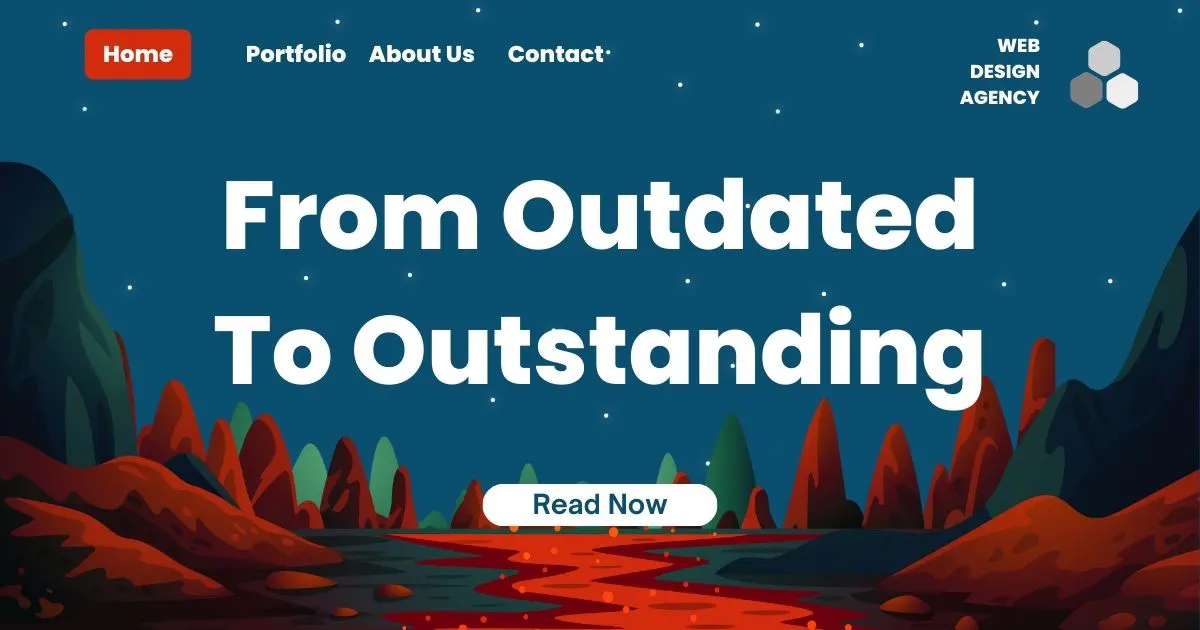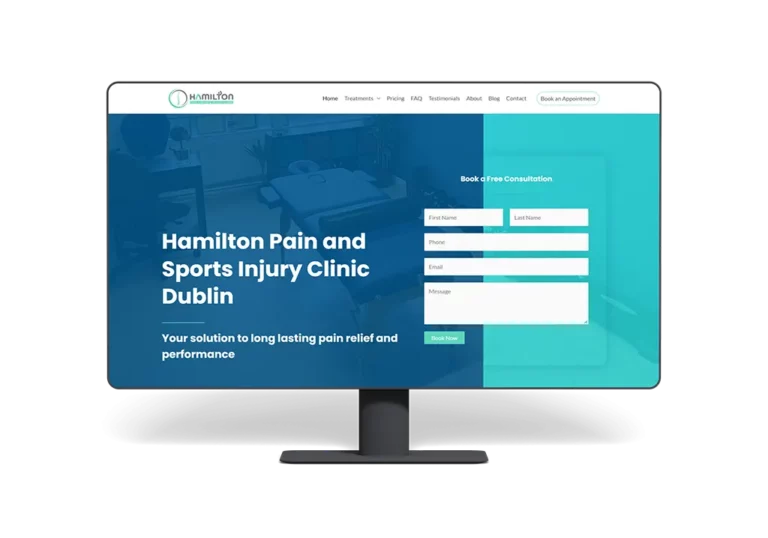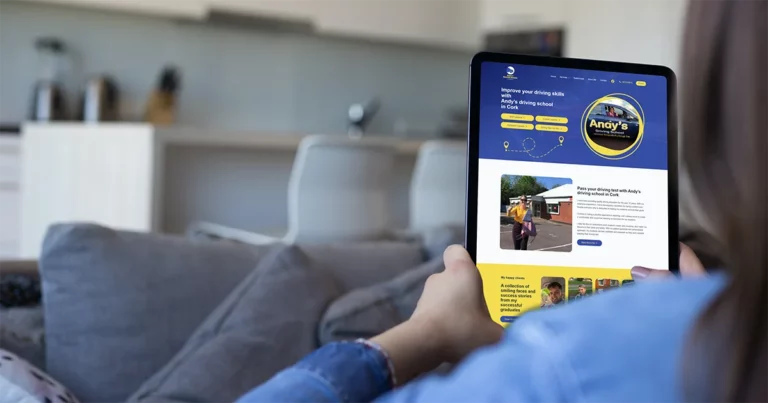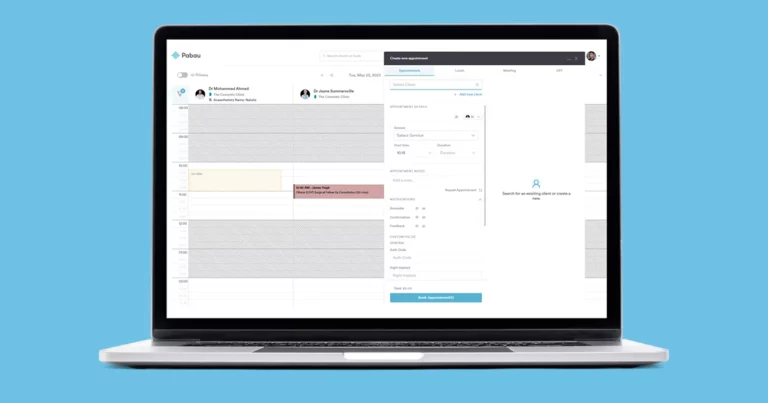Introduction: The Digital Fashion Faux Pas
Ah, the world of websites – a realm where the phrase ‘fashionably late’ doesn’t quite cut the mustard. It’s a bit like turning up to a party in your finest 1990s getup, complete with frosted tips and baggy cargo pants, only to realize it’s 2023. Yes, your website might have been the bees’ knees back when ‘Friends’ was still airing new episodes, but times have changed, my friends. And in the digital world, outdated is just out.
Now, let’s talk about first impressions online. They’re like those speed dating rounds – you’ve got but a fleeting moment to dazzle before your potential customer swipes left in search of something a bit more… current. In an age where a single click is all it takes to find an alternative, your website is the digital handshake, the front door, the ‘how do you do’ of your business. It’s where relationships begin, or in the case of a website that’s seen better days, where they end before they’ve even started.
Remember, your website is often the first interaction a potential customer has with your business. Ensuring it’s modern, appealing, and up-to-date isn’t just about aesthetics; it’s about making a positive, lasting impression that invites engagement and trust. An outdated website not only risks losing potential customers but can also diminish your brand’s perceived value and professionalism. Keep it fresh, keep it current, and watch your digital doorstep become a welcoming beacon in the vast sea of the internet.
The High Cost of Staying in the Past: Digital Déjà Vu
Picture this: you’re rocking up to a high-powered board meeting, decked out in a 1970s disco outfit, complete with bell-bottoms and a butterfly collar. Sure, you might be remembered, but perhaps not for the reasons you’d like. This, my friends, is the online equivalent of sporting an outdated website in the fast-paced, ultra-modern digital world. It’s less “Saturday Night Fever” and more “Monday Morning Misstep”.
In the realm of websites, clinging to the past is like stubbornly holding onto that VHS collection while the world streams in 4K. An archaic website isn’t just a visual misstep; it’s a neon-flashing sign telling your customers, “We might not be up to speed!” In an era where online credibility is king, an outdated site can cause your customers to undervalue your business faster than you can say “dial-up internet”.
But it’s not just about being judged for outdated aesthetics. It’s like bringing a knife to a gunfight – you’re simply under-equipped. While your competitors are wooing customers with sleek, user-friendly sites, your digital presence is lurking in the shadows of Web 1.0, trying to load a Flash animation that nobody has the patience to wait for.
Maintaining a modern and updated website is crucial for staying competitive and relevant in today’s market. It’s not just about looking pretty; it’s about functionality, user experience, and meeting the expectations of a technologically savvy audience. An outdated website can significantly hinder your business’s growth, as it may lead to diminished trust and lost opportunities. Regular updates, contemporary designs, and keeping pace with current web standards are not just beneficial – they’re essential for the health and success of your online presence. Remember, in the digital world, staying current isn’t just a trend, it’s a survival strategy.
Giving Competitors an Edge: Digital Charity for Rivals
Imagine, if you will, that you’re in a grand old race – not one of those fancy, high-tech Formula 1 races, but rather the kind where your competitors zoom past in sleek, modern vehicles, and you’re chugging along in a charming, yet highly impractical, vintage car. Your outdated website is the digital equivalent of that car: it has character, sure, but in terms of getting you to the finish line (or in business terms, winning customers), it’s about as useful as an ashtray on a motorcycle.
Now, let’s paint a picture. You’re in the business battlefield, armed with your trusty website that looks like it was built when the internet was a toddler. Every time a potential customer visits your site and recoils in horror at the antiquated design and clunky navigation, it’s like you’re cheerfully handing your competitors a glittering advantage on a silver platter. “Here you go, folks. Don’t mind me, just giving you a leg up in the business world.”
But wait, there’s more. This isn’t just about aesthetics; it’s about functionality and user experience. An outdated website in today’s fast-paced digital world is like showing up to a smartphone convention with a rotary phone. It’s not just quaintly out of touch; it’s a glaring signal that you’re not keeping up with the times. And in the cutthroat world of business, that’s akin to giving your competitors the secret family recipe – and then watching them open a restaurant right next door.
Keeping your website updated and in line with current trends and technologies is essential to maintain a competitive edge. An outdated website can unintentionally drive customers to your competitors, not just because of its appearance, but also due to poor functionality and user experience. It’s vital to regularly assess and update your website, ensuring it aligns with modern standards and expectations. This proactive approach not only retains existing customers but also attracts new ones, reinforcing your business’s credibility and relevance in an ever-evolving digital landscape. Remember, in the digital race, staying current and efficient isn’t just about keeping up; it’s about not giving away your competitive advantage.
The Mobile Dilemma: A Tale of Square Pegs and Round Holes
In the grand theatre of the internet, there’s a tragicomedy unfolding that could rival any Shakespearean play – it’s the tale of outdated, non-responsive websites in a world dominated by smartphones. Imagine this: a world where everyone is glued to their mobile devices, from the high-flying executive in Dublin’s Silicon Docks to the farmer in rural Cork checking the weather. Yet, there you are, with a website that treats mobile compatibility as an optional extra, like a car salesman in the ’80s suggesting seat belts as a fancy add-on.
Navigating an old website on a mobile device is a bit like trying to fit a square peg in a round hole – using a sledgehammer. It’s a frustrating experience where users have to pinch, zoom, scroll, and maybe even perform a little interpretative dance just to find basic information. It’s the digital equivalent of trying to read a newspaper through a keyhole. And let’s not forget the loading times, reminiscent of waiting for a kettle to boil in a time before electricity.
But wait, there’s more comedy in this tragedy. While you’re trying to convince your website to behave on a smartphone, your customers are bouncing off to greener, more mobile-friendly pastures. It’s like hosting a party and then realizing all your guests have snuck off to the livelier bash next door because you didn’t have snacks – or Wi-Fi.
Having a mobile-responsive website is not just a luxury; it’s a necessity. The majority of internet browsing occurs on mobile devices, making mobile responsiveness crucial for user engagement and retention. A non-responsive website not only frustrates users but also severely impacts your site’s visibility and ranking on search engines. Investing in a responsive design ensures your website is accessible and user-friendly across all devices, ultimately enhancing user experience and expanding your audience reach. Remember, in the digital world, adaptability is key – your website should be as flexible as the devices it’s viewed on.
Trust and Tech Savvy: Judging the Digital Book by Its Cover
In the digital age, your website is the glossy cover to the epic novel that is your business. And let’s face it, we’re all judging that book by its cover. A modern website is like a firm handshake in the digital world – it instantly builds trust. If your website looks like it was built when “Friends” was still airing new episodes, people are going to assume that your business might also be stuck in that era. That’s right, they’ll think you’re still using fax machines and listing your email address as an “electronic mail” contact point.
Imagine this: you walk into a store, and it’s like stepping into a time machine. The decor screams 1990s, the cash register is an antique, and the staff are wearing flannel shirts and listening to Nirvana. Charming for a themed cafe, perhaps, but not the vibe you want for a tech-savvy business in 2023. An outdated website sends the same message: “We might still be using dial-up internet.”
Now, let’s be clear, having a cutting-edge website doesn’t mean it needs to look like it’s been designed by a Silicon Valley whiz kid on a caffeine binge. It just means it should reflect that you know what century it is. A modern website suggests that you’re up to date, not just with technology, but with current market trends, customer needs, and yes, even memes.
In today’s competitive market, a modern and updated website is essential for establishing trust and showcasing your business’s tech savviness. It’s the first point of interaction many customers will have with your brand, and a well-designed site can significantly impact their perception and confidence in your services. An updated website signals that you are relevant, forward-thinking, and attentive to customer experience. It’s a critical investment that speaks volumes about your business’s credibility and professionalism. Remember, in the digital world, your website is your storefront, and keeping it modern is key to inviting customers in.
The SEO and Accessibility Tango: Hosting the Party of the Century, but Oops, No Invites!
So, you’ve decked out your website with all the bells and whistles of the early 2000s – a touch of Flash animation here, a sprinkle of frames there, and let’s not forget the pièce de résistance, the visitor counter at the bottom. It’s like throwing the ultimate millennium bash but in 2023. And here’s the kicker: Google, the lord of the search engine realm, wasn’t even invited to this retro shindig. That’s modern website design and SEO for you – a tango where one partner is ready to rumba and the other is doing the robot.
Now, let’s talk accessibility. Imagine you’ve organized the most fabulous party – great music, amazing food, the works. But oops, you’ve forgotten to send out the invites. That’s your state-of-the-art website without proper accessibility features. Sure, it looks great to you, but if people can’t find it or navigate through it, it’s as good as a ghost town. And no, telling your users to “just press Tab a few more times, you’ll eventually find the menu” doesn’t count as accessibility.
Let’s not forget our dear friends, the search engines. They’re like the party planners of the internet. If they can’t waltz through your website with ease, they’re not going to recommend it to others. In other words, if your website isn’t modern, search engines are going to bypass it faster than a vegan at a barbecue festival.
Prioritizing SEO and accessibility in your website design is not just about staying trendy; it’s a strategic move to enhance visibility and user experience. A modern website design positively influences SEO, making it easier for search engines to crawl and index your content. This translates to higher rankings and increased visibility. Similarly, incorporating accessibility features ensures that your website is usable and navigable for all users, including those with disabilities. This inclusivity not only broadens your audience reach but also reflects your brand’s commitment to catering to diverse user needs. In essence, updating your website is like extending a warm, welcoming invitation to both search engines and users, ensuring everyone can join the party.
What Your Website Says About You: The Fashion Police of the Digital World
Picture this: You’re strolling down the streets of Dublin, and there’s this guy – let’s call him Derek – wearing socks with sandals. Not just any socks, but those with individual toes. It’s a fashion statement, sure, but not the kind you want to make. This, my friends, is akin to what your outdated website is screaming to the world. It’s the digital equivalent of Derek and his toe-sock-sandal combo. Your website is not just a collection of pages and links; it’s your business’s wardrobe, and right now, it might be stuck in the ’90s.
Imagine your website attending a business meeting. While all the other sites are rocking sleek, responsive designs and snappy content, yours shows up with a cluttered homepage, Comic Sans font, and a guestbook for people to sign. It’s like bringing a cassette tape to a Spotify-streaming party. And let’s not forget about those websites with autoplay music – it’s like your uncle trying to DJ at a family gathering. He means well, but it’s painfully out of touch.
Your website speaks volumes about your business. It’s the first port of call for many customers, and in the age of digital sophistication, first impressions matter. A modern, up-to-date website tells your customers that you’re keeping up with the times, much like swapping out that Nokia 3310 for a smartphone. It’s about showing that you’re evolving, improving, and ready to meet your customers’ needs – both now and in the future.
In today’s fast-paced digital era, having a modern and updated website is crucial for maintaining a positive business reputation. Your website often serves as the first point of interaction with potential customers, and an outdated design can lead to negative perceptions about your business’s quality and relevance. Investing in a contemporary, user-friendly, and aesthetically pleasing website design not only enhances user experience but also significantly boosts your business’s credibility. By ensuring that your website accurately reflects your brand’s values and commitment to current trends and technologies, you solidify your business’s reputation as professional, reliable, and forward-thinking. Remember, your website is more than just a digital presence; it’s a representation of your brand’s identity and ethos.
The Power of First Impressions: Web Design’s Handshake Etiquette
Alright, let’s chat about first impressions. Imagine walking into a networking event. You’re feeling sharp, ready to charm the room with your wit and charisma. You extend your hand for that firm, assertive handshake – the universal symbol of confidence and competence. Now, transpose that scenario onto the digital stage. Your website is your business’s outstretched hand. But what if, instead of that confident grip, your website offers the equivalent of a limp, clammy handshake from a wet fish? Not the impression you’re aiming for, right?
Navigating to a modern website is like walking into an impeccably designed office. The décor is inviting, the ambiance is just right, and you’re greeted with a warm, confident smile. In contrast, an outdated website is like stumbling into a musty room, with décor that screams ‘grandma’s living room’ circa 1985. It’s about as welcoming as a cold cup of tea. It’s awkward, off-putting, and leaves visitors rushing for the exit – or in this case, the ‘back’ button.
This is the digital age, where your website often makes the first introduction to potential clients. It’s where impressions are formed in milliseconds. A modern, sleek website design assures visitors that they’re in capable hands. It’s like saying, “Yes, we know what we’re doing, and we’re darn good at it!” On the flip side, an outdated design is like saying, “We still think floppy disks are cutting-edge technology.” It raises doubts about your ability to deliver current, high-quality services or products.
First impressions are incredibly powerful, particularly in the digital realm where decisions are made swiftly. A modern and professionally designed website acts as a strong, positive introduction to your business, instilling trust and confidence in your audience. It demonstrates your commitment to quality and relevance in today’s fast-evolving market. Ensure that your website accurately reflects your brand’s professionalism and dedication to excellence. Remember, in the business world, your website’s first impression can be the difference between securing a new client or losing them to competitors. A well-designed website is not just about aesthetics; it’s an essential tool for establishing credibility and engaging effectively with your audience.
The Balancing Act: Keeping it Timeless Yet Contemporary
You’re at a party, and there’s that one person who’s dressed like they’ve time-traveled straight from the 70s, disco ball and all. Sure, they stand out, but for all the wrong reasons. That, my friends, is the equivalent of a website that’s stuck in its glorious past. It’s the digital version of bell-bottoms and psychedelic prints in a world where sleek minimalism reigns supreme.
Now, let’s not get too carried away. The goal here isn’t to chase every web design trend like it’s the last bus on a rainy night. That’s a one-way ticket to becoming a fashion victim in the web world. Remember the blink tag? Yes, that was a thing. Websites blinking like a disco light, thinking they were the height of digital sophistication. Spoiler alert: they weren’t.
Crafting a website that’s both timeless and modern is like finding the perfect pair of jeans. They’re classic, never go out of style, but with a contemporary twist that says, “Hey, I’m keeping up with the times.” It’s about striking the right balance between classic elegance and modern functionality. Think of it like a classic black tuxedo with a smartwatch – timeless style with a nod to modern tech.
But beware the siren song of overdoing it. You don’t want your website to be like that person who tries every fashion trend at once. It’s not just confusing; it’s a visual catastrophe. One moment, you’re navigating a simple menu; the next, you’re lost in a sea of parallax scrolling, hamburger menus, and autoplay videos. It’s the web design equivalent of wearing socks with sandals – a confusing mix that leaves everyone wondering, “Why, though?”
A well-designed website should stand the test of time while embracing elements of modern design to stay relevant and functional. It’s crucial to find the right balance between classic design principles and contemporary aesthetics. This balance ensures your website remains effective and engaging for years, without needing a complete overhaul with each passing web design trend. Aim for a clean, user-friendly design that aligns with your brand identity, and incorporates current best practices in navigation, responsiveness, and user experience. Remember, good design is not just about looking great; it’s about creating a seamless and enjoyable experience for your visitors.
Conclusion
Alright, let’s land this digital ship. We’ve journeyed through the cyber realms of outdated websites and why they’re about as appealing as a VHS tape at a Netflix party. Now, it’s time to face the music, or more appropriately, update your playlist. Yes, we’re talking about giving your website that much-needed leap into the 21st century.
Imagine your website is at a party. You don’t want it to be that one guest who’s still stuck in the disco era, complete with bell-bottoms and a glitter ball, while everyone else is grooving to the latest EDM beats. Your website strutting its outdated stuff is like showing up to a smartphone convention with a pager. It’s not just retro; it’s practically prehistoric.
So, here’s a friendly nudge, or a full-on shove, towards modernizing your website. Think of it as swapping your disco ball for a smart home hub. It’s about making your digital presence as current as your morning latte order – oat milk, extra shot, no foam. It’s not just about keeping up with the Joneses; it’s about outpacing them with style and functionality.
In the fast-paced world of the internet, being trendy isn’t just a vanity project. It’s about being relevant, accessible, and a step ahead of your competitors. It’s about ensuring that when potential clients or customers land on your site, they don’t think they’ve accidentally time-traveled to the early 2000s. Remember, in the digital dance of business, you want to be the one leading the waltz, not doing the moonwalk in the wrong direction.
So, if your website is still partying like it’s 1999, it’s time for an intervention. Don’t let it be the digital equivalent of a dad at a rave. Give it the glow-up it deserves. And if the thought of diving into the world of website redesign feels more overwhelming than explaining TikTok to your grandma, fear not!
Contact Fit Bee
That’s where we, at Fit Bee, swing into action. We’re here to help you transform your website from a digital dinosaur to a cyber superstar. Whether it’s a full-on facelift or just a nip and tuck, we’ve got the tools, the talent, and the tea (yes, we’re Irish; tea is essential) to bring your website into the now. Contact us today, and let’s turn your website into something that even the coolest of digital natives would give a thumbs up to. Because in the world of web design, staying on top of the trends isn’t just good business; it’s survival.















